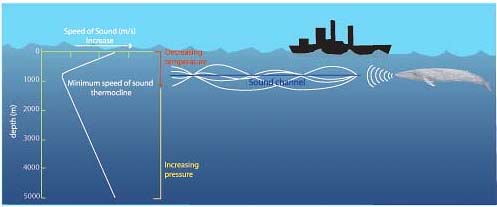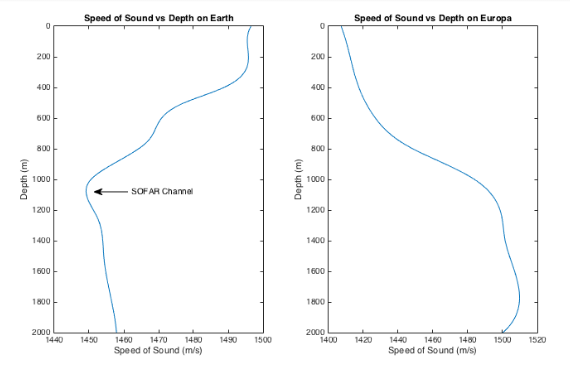Extraterrestrial SOFAR Channels
The SOFAR channel is a acoustic waveguide that exists in the Earth's oceans at a depth of about 500 meters. The basic mechanism is somewhat similar to a the optical effect that gives rise to a mirage. At a certain depth the speed of sound reaches a minimum. This causes sound waves to refract at theis depth. Waves moving up will bend down, and waves moving down will bend upwards. The result is that sound gets trapped at this depth and instead of dropping off as a function of distance squared, it drops off as a function of distance (dimensionality is ubiquitous). The basic mechanism is illustrated below (courtesy of NOAA).

The SOFAR channel is widely used by whales to communicate. Several species of whales will dive down the the SOFAR channel and repeatedly sing messages to other whales. Recently, humans have also started sending sound in the SOFAR channel for oceanographic research and submarine warfare (to the detriment of whales). The SOFAR Channel is an interesting place in the deep ocean.
Naturally the question can be asked: is this a phenomena that happens everywhere, or is it unique to the Earth's oceans? The SOFAR channel is created by the speed of sound reaching a minimum at a certain depth, so anytime there exists a local minima in the speed of sound there should also be an acoustic waveguide. The cause of the minimal speed of sound is the result of a complicated interplay between Pressure and Temperature in the Earth's oceans. The speed of sound increase with Pressure, which increases linearly with depth. In the Thermocline (the top layer of the Earth's oceans), the temperature drops rapidly with depth - causing the speed of sound to drop. In the Thermocline, the effect of temperature outweighs the effect of pressue, which causes the speed of sound to drop with depth. Once the temperature gradient flattens out the effect of pressure becomes dominant, and the speed of sound increases with depth.
One possible scenario where a SOFAR channel would be interesting is extraterrestrial oceanography. We know that Jupiter's moon Europa has oceans beneath its surface. If it had a SOFAR channel this might be useful for extraterrestial oceanographic research. Unfortunately this is not the case. The temperature gradient on Europa is inverted due to the freezing outside temperature and the internal tidal heating of the moon. While there is still the possibility that there could exist local minima in the speed of sound related to changes in salinity, these are typically small and this seems unlikely.
